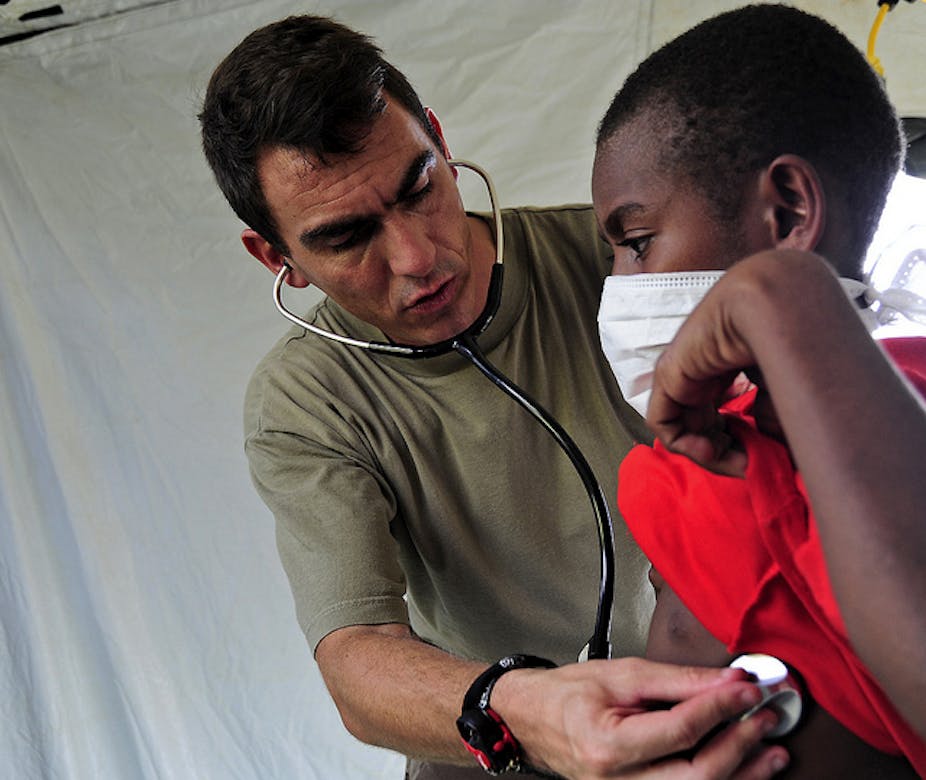Papua New Guinea (PNG) is currently in a battle with potentially preventable and treatable tuberculosis, as reported in today’s Age and Sydney Morning Herald newspapers. The disease has increased in the Pacific nation by 42% over the past decade.
Professor Guy Marks, Head of Epidemiology at the University of Sydney’s Woolcock Institute, explains why the World Health Organisation is concerned about the spread of multi-drug resistant tuberculosis:
Tuberculosis (TB) is an infectious disease that’s passed on when a person with tuberculosis of the lungs coughs and another person inhales the TB organism – mycobacterium tuberculosis – into the lungs.
About a third of the world’s population is infected with the organism that causes TB. But only 10% of these people will go on to develop the disease. Once you’re infected, you can develop the disease at any time but it’s most likely to occur within two years.
The common forms of tuberculosis are treatable by antibiotics but this can be quite complicated. A standard course of treatment requires four different drugs (daily or three times a week) over a two month period, and then two of those drugs to continue for a total of six months.
Unless the treatment is closely supervised, people to tend take only a partial course of these drugs. This is because the symptoms of the disease usually disappear quite quickly but the drugs can be difficult to access and may cause side-effects.
Unfortunately, taking a partial course of treatment means that the disease is likely to relapse and, worse still, may relapse in a drug resistant form. The organism mutates to develop a resistance to one antibiotic; the multiple antibiotics are used to prevent those mutations from surviving.
Drug resistant TB can be transmitted to others, just like drug-susceptible TB. Drug resistant TB is much more difficult to treat than the usual, drug-susceptible disease.
Is multi-drug resistant TB a more severe strain?
The strain is still the same organism but it can’t be treated with the standard drugs.
The drugs that can treat it are less effective, more toxic and more expensive. And because they’re less effective, treatment is required for much longer. So it’s much more difficult to treat.
How serious are the outbreaks of multi-drug resistant tuberculosis in Papua New Guinea?
I don’t think anybody really knows how serious the situation is because there’s very little data. In many countries, including PNG, the organisms are not routinely tested for drug resistance. In this situation the only way you know you’re dealing with multi-drug resistant TB is when the standard treatments fail.
We do have data from clinics in the Torres Strait Islands, which test for drug susceptibility. Visiting clinicians have found a very high proportion of patients have multi-drug resistant tuberculosis. So we can assume it’s also common in PNG.
Why is TB so prevalent in Papua New Guinea?
There are many factors. Much of it has to do with living conditions in crowded houses – this promotes the spread of the disease.
Also, the prevalence of other illnesses increases the likelihood of latent TB infection progressing to TB disease.
But the biggest problem is when the disease takes hold in an area and there’s no effective program for controlling the disease, then tends to spread.
How can TB be controlled?
You control the spread of tuberculosis by finding people with active tuberculosis early (soon after developing symptoms), putting them on effective medications and making sure they continue their treatment until completion.
Is there a risk this multi-drug resistant TB could spread to Australia?
Australia has a very good TB control program. Everybody who comes to Australia from countries with high rates of tuberculosis is screened for active TB. If they have the disease, they can’t come until they’re clear.
But the issue with tuberculosis is that the disease is latent in many people and the screening process doesn’t pick this up.
And if it did, I’m not sure what we’d do with that information – it’s so common and affects a third of the world’s population.
Tuberculosis isn’t a major problem in Australia – we have it under pretty good control. There are around 1,200 cases a year in Australia and most (about 85%) occur in people who were born overseas and acquired their infection before coming to Australia, where it reactivated. Transmission of tuberculosis within Australia is uncommon.
Rates of multi-drug resistant tuberculosis in Australia have remained stable over many years and account for around 2% of cases.
This is despite the increase of multi-drug resistant TB in many countries from which from which Australia has visitors and migrants.
What are Australia’s responsibilities to help contain TB in the region?
Australia’s role is to assist PNG and other countries to increase their capacity to deal with this problem themselves.
This requires a substantial investment of funds, training, and, in some cases, the supply of health professionals.
PNG needs laboratories to make diagnoses, it needs skilled clinicians and supervisors to treat the disease, and it needs funds to purchase the drugs. These are the necessary steps to effectively manage contain the disease.
Papua New Guinea has enormous problems, of which tuberculosis is only one. But containing the TB requires that this disease be elevated as a priority.
The Australian Government today boosted its support for PNG to respond more effectively to TB with an additional $1.1 million. Click here for more.

